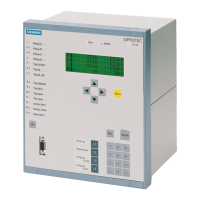2 Functions
350
7SD5 Manual
C53000-G1176-C169-1
The double-ended fault locating method used here has the following advantages over
the single-ended method:
• Correct fault locating is possible even with power flowing in the line, with double-
sided infeed and high fault resistances.
• The precision of fault locating is not affected by an inaccurate setting of the earth
impedance compensation.
• The method is stable against the influence of a parallel line, so parallel line compen-
sation is not required.
• The accuracy can be increased if the line asymmetry (selection of the central con-
ductor) is taken into account.
Output of the Fault
Locator
The fault locating issues the following results:
• The short-circuit loop which was used to determine the fault reactance,
• The reactance X in Ω primary and Ω secondary,
• The resistance R in Ω primary and Ω secondary,
• The distance to fault d in kilometers or miles of the line proportional to the reac-
tance, converted on the basis of the set line reactance per unit line length,
• The distance to fault d in % of the line length, calculated on the basis of the set re-
actance per unit length and the set line length.
The additional indications always show the results of single-ended fault locating.
• Where double-ended fault locating is configured, the results of single-ended fault
locating are output in any case in additional indications
– „Rpri single. =“ (No.1135),
– „Xpri single. =“ (No.1136),
– „Rsec single. =“ (No.1137) and
– „Xsec single. =“ (No.1138)
• If the double-ended fault locator fails, they are output as „main results“ in the indi-
cations
– „Rpri =“ (No.1114),
– „Xpri =“ (No.1115),
– „Rsec =“ (No.1117) and
– „Xsec =“ (No.1118)
.
The fault location indicated in per cent can, at the same time, be output as BCD-code
(Binary Coded Decimal). This, however, must have been preset in address 138 during
the configuration of the protection functions (Section 2.1.1.3). A further prerequisite is
that the required number of binary outputs is allocated for this purpose.
10 output relays are needed. They are classified as follows:
• 4 outputs for the units (1·2
0
+ 1·2
1
+ 1·2
2
+ 1·2
3
),
• 4 outputs for the tens (10·2
0
+ 10·2
1
+ 10·2
2
+ 10·2
3
),
• 1 output for the hundreds (100·2
0
),
• 1 output for the ready-state annunciation „BCD dist. VALID“ (No. 1152).
Once a fault was located, the corresponding binary outputs pick up. Then the output
„BCD dist. VALID“ signals that the data are now valid. The duration can be se-
lected. In the event of a new fault, the data of the former fault are cleared automatically.
www . ElectricalPartManuals . com

